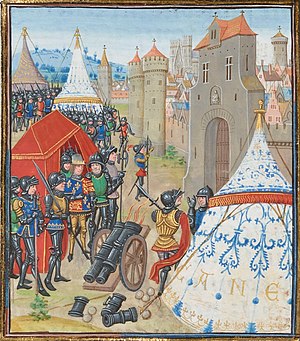Reims campaign
| Reims campaign | |||||||
|---|---|---|---|---|---|---|---|
| Part of the Hundred Years' War | |||||||
 Edward III before Reims | |||||||
| |||||||
| Belligerents | |||||||
|
|
| ||||||
| Commanders and leaders | |||||||
|
Earl of Warwick |
Dauphin Charles | ||||||
The Reims campaign took place during the Hundred Years' War. It occurred after the French de facto government rejected the terms of the Treaty of London and consequently Edward III of England organised and commanded an expeditionary army to gain by force what he had failed to win by diplomacy. On 28 October 1359 Edward landed at Calais, and advanced to Reims, where he hoped to be crowned king of France. The strenuous resistance of the citizens frustrated this scheme, and Edward marched into Burgundy, and then he made his way back towards Paris. Failing in an attack on the capital, he was glad to conclude, on 8 May 1360, preliminaries of peace at Brétigny, near Chartres. This treaty, less onerous to France than that of London, took its final form when Edward and John ratified the treaty in Calais on 9 October 1360. By it Edward renounced his claim to France in return for Aquitaine and other French territories in full sovereignty.[1]
Prelude
After his defeat and capture at the
In March 1359 the
The
Expedition
Having raised an immense force, and furnished it with everything that could be needed during a long campaign, Edward III sailed from
On 10 March Duke Philip bought Edward III off by a payment of two hundred thousand gold 'moutons',[6] and he then marched to Paris and encamped between Montlhéry and Châtres, lodging at the castle of Saint-Germain-lès-Arpajon. Edward did not succeed in provoking Charles, the regent of France, to battle, and on 6 April marched towards the Loire, intending to refresh his men in Brittany and commence operations again later in the year.[2] However, on 13 April 1360 (Black Monday), the English army was hit by a hailstorm and suffered a loss of over 1,000.[7] Meanwhile, on 15 March, a French fleet had appeared at Winchelsea, carrying a large force of soldiers, who plundered the town and were at last driven to their ships.
These events improved the French position and Charles, the regent of France, now pressed for peace. The
Aftermath
By the terms of the Treaty of Brétigny the whole of the ancient province of Aquitaine, together with Calais, Guisnes, and Ponthieu, was ceded to Edward. Edward renounced his claim to the crown, to the provinces north of the Loire, and to the overlordship of Flanders. The right to Brittany was left undecided, and provision was made that any future struggle for the duchy between the two competitors should not involve a breach of the treaty. The ransom to be paid for King John II, was fixed at three million gold crowns, at an exchange rate of two to the noble, six thousand to be paid in four months, and hostages to be delivered, and the king to be then set free. It is noted that a nineteen or twenty year old Geoffrey Chaucer was captured at this siege but was ransomed by Edward III for £16. These terms were slightly more favourable to the French compared to the Treaty of London.
Edward returned thanks in the
Notes
- ^ Tout 1911, p. 995.
- ^ a b c d e Hunt 1889, p. 62.
- ^ Hunt 1889, p. 62 cites Fœdera iii. 452; Hardy 1869, p. 404.
- ^ Hunt 1889, p. 62 cites Jehan le Bel, vol. ii. p. 251).
- ^ Hunt 1889, p. 62 cites Cont. Will, of Nangis, ii. 297.
- ^ Hunt 1889, p. 62 cites Fœdera, iii 473; Hardy 1869, p. 406.
- ^ History.com, https://www.history.com/this-day-in-history/hail-kills-english-troops, viewed on 3 January 2021
- ^ Hunt 1889, p. 95.
- ^ "Not Harfleur as Froissart has it, for it was then in French hands" (Hunt 1889, p. 62)
- ^ Hardy 1869, p. 411.
- ^ Hunt 1889, p. 62 cites Fœdera, iii. pp. 515 sq; Hardy 1869, p. 411.
- ^ Hunt 1889, p. 63 cites Walsingham, i. 294.
References
- Rymer, Thomas (composer) (1869). Hardy, Sir Thomas Duffus (ed.). Syllabus (in English) of the documents relating to England and other kingdoms contained in the collection known as "Rymer's Foedera.". Vol. I. Public Record Office. pp. 404, 406, 411.
- Hunt, William (1889). . In Stephen, Leslie (ed.). Dictionary of National Biography. Vol. 17. London: Smith, Elder & Co. p. 58.
Attribution:
- This article incorporates text from a publication now in the public domain: Tout, Thomas Frederick (1911). "Edward III.". In Chisholm, Hugh (ed.). Encyclopædia Britannica. Vol. 8 (11th ed.). Cambridge University Press. p. 995.
 This article incorporates text from a publication now in the public domain: Hunt, William (1889). "Edward III". In Stephen, Leslie (ed.). Dictionary of National Biography. Vol. 17. London: Smith, Elder & Co. p. 62–63. endnote
This article incorporates text from a publication now in the public domain: Hunt, William (1889). "Edward III". In Stephen, Leslie (ed.). Dictionary of National Biography. Vol. 17. London: Smith, Elder & Co. p. 62–63. endnote
- Polain, Matheu-Lambert (ed.). Chroniques de Jehan le Bel. Académie Impériale. (archive.org
- Walsingham Rolls Ser.
